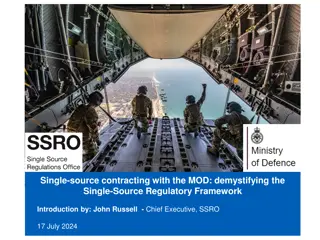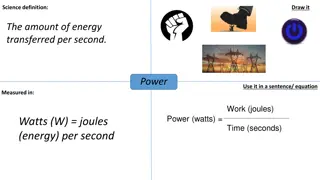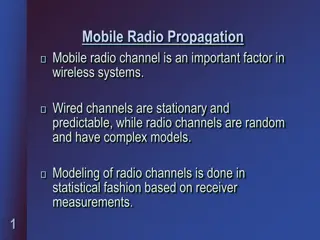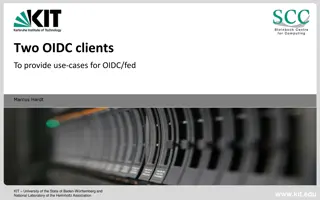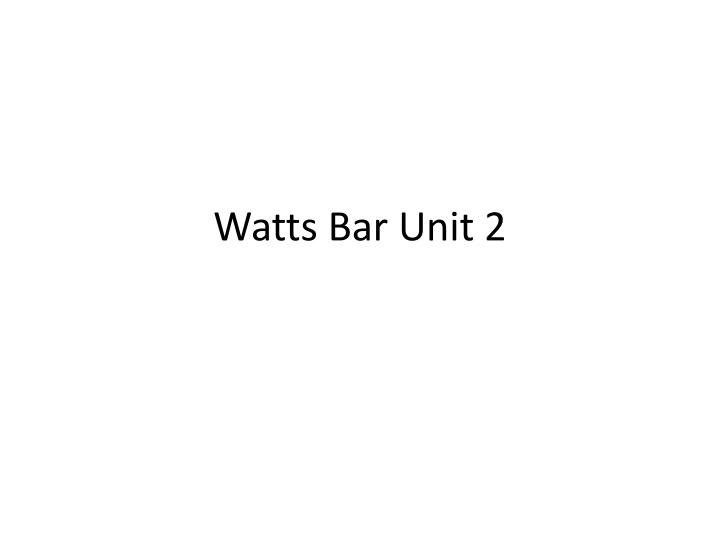
Challenges of Watts Bar Unit 2 Construction Revealed
Discover the tumultuous history of the Watts Bar Unit 2 construction project, plagued by mismanagement, cost overruns, safety compromises, and delays in implementing crucial upgrades post-Fukushima disaster. The federally-owned Tennessee Valley Authority (TVA) faces scrutiny for its handling of this nuclear reactor project, raising concerns about its viability and safety standards.
Download Presentation

Please find below an Image/Link to download the presentation.
The content on the website is provided AS IS for your information and personal use only. It may not be sold, licensed, or shared on other websites without obtaining consent from the author. If you encounter any issues during the download, it is possible that the publisher has removed the file from their server.
You are allowed to download the files provided on this website for personal or commercial use, subject to the condition that they are used lawfully. All files are the property of their respective owners.
The content on the website is provided AS IS for your information and personal use only. It may not be sold, licensed, or shared on other websites without obtaining consent from the author.
E N D
Presentation Transcript
More than four decades after construction began in 1973, the Tennessee Valley Authority (TVA) is finally getting close to starting up the Watts Bar Unit 2 nuclear reactor. While the TVA and the nuclear industry describe Watts Bar 2 as the first new nuclear generation of the 21st Century, in fact the TVA resuscitated a demonstrably unsafe 1960s-era ice condenser design that was abandoned decades ago by the rest of the nuclear industry. Bulletin of the Atomic Scientists 10/08/2015
Mismanagement and construction problems have driven the project s price tag up with billions of dollars in cost overruns. Safety continues to be compromised as the NRC is allowing the TVA to delay post-Fukushima seismic design upgrades indefinitely. Rather than exemplifying a fine technological achievement, the history of Watts Bar Units 1 and 2 is a cautionary tale of the worst pitfalls of nuclear power and the federal regulatory system.
Watts Bar 2 comes from a federally owned utility that has a history of delays, problems, and fiscal irresponsibility when it comes to nuclear power. This history raises the question of why Watts Bar 2 has survived such a long time and whether it should ever be allowed to open. It is a saga of delays and cost overruns, antiquated designs, inadequate quality control and oversight, failure to implement post- Fukushima upgrades, and a deficient safety culture, among other problems all at a time when there is still no place for long-term storage of the nuclear waste that will be generated. And because the TVA manufactures tritium for use in America s nuclear weapons, there will inevitably be greater releases of tritium into the air and water of the region natural resources which already receive four times as much tritium as originally expected.
The Tennessee Valley Authority now tallies the cost of completing Watts Bar 2 to be about $4.4 billion. Add the $1.7 billion sunk into the project before 1985 and Watts Bar 2 will cost about $6.1 billion. The combined Watts Bar project cost of almost $13 billion is nearly 16 times the original projection, not including the interest on the construction debt.
Post-Fukushima design upgrades postponed. In the aftermath of the 2011 Fukushima disaster in Japan, the NRC s high-level Near-Term Task Force advised the NRC Commissioners to order licensees to reevaluate the seismic and flooding hazards at their sites against current NRC requirements and guidance and, if necessary, to update the designs and safety systems to protect against the updated hazards. The Task Force also recommended that this effort be completed for Watts Bar 2 before licensing of the reactor. Subsequently, the TVA found that the earthquake risk to Watts Bar 2 exceeds the reactor s design but the NRC s commissioners decided that it was not necessary to fully address these risks before licensing Watts Bar 2. They later rebuffed a request by the Southern Alliance for Clean Energy to reconsider its decision.
Do you agree with the Nuclear Regulatory Commission that it is not necessary to fully address earthquake and flooding risk before the reactor opens? A. Yes B. No C. Not enough information
During Watts Bar Unit 2s more than forty-year long journey to completion, renewable energy and energy efficiency have undergone revolutionary advances and cost reductions. Renewables are growing worldwide at increasingly rapid rates as costs plummet; by way of example, the cost of solar panels has dropped by 80 percent in the past five years. And the TVA currently is being offered 3500 megawatts of wind power from Oklahoma from Clean Line Energy Partners at a very competitive cost. This revolution undermines any justification of the risk, environmental harm, cost, and proliferation issues of nuclear power. Without the need for nuclear power, Iran and other countries that covet nuclear weapons would have no justification to enrich uranium and no cover to hide their nuclear weapons aspirations.
Is new nuclear power generation turning out to be the failed technology of the 21st Century? (a conclusion of The Bulletin of Atomic Scientists) A. Yes B. No C. Not enough information
America's newest nuke plant shows why nuclear power is dying in the U.S. This is a story by columnist Michael Hiltzik from The Los Angeles Times, October 12, 2015 "Rather than exemplifying a fine technological achievement," environmentalists Don Safer and Sara Barczak write on the website of the Bulletin of the Atomic Scientists, "the history of Watts Bar Units 1 and 2 is a cautionary tale of the worst pitfalls of nuclear power and the federal regulatory system." As they observe, the history of Watts Bar is one of enormous cost overruns, antiquated design and unimaginable construction delays. Most of those features are shared with America's nuclear power industry in general, which may explain why the industry is held in such low esteem and regarded with so much fear by the public that the last new nuclear plant to enter service in the U.S. is now nearly 20 years old -- the 1996-vintage Watts Bar Unit 1.
Watts Bar 2 holds the world record for the longest gestation of any nuclear plant in history, having been listed as "under construction" for 43 years. The project was launched in 1972 and suspended in 1985, when it was already 60% complete, Safer and Barczak observe. By then, despite an initial cost estimate of about $400 million, some $1.7 billion had been spent. The total cost is now estimated at $6.1 billion. TVA officials say that upgrades and improvements, including safety provisions implemented following Japan's 2011 Fukushima power plant disaster, have made Unit 2 "like new."
The fundamental problem of the U.S. nuclear power program may have been that it was placed under the management of the nation's power utilities, which were ill-equipped to manage a technology vastly more complicated than any it had dealt with up to that point. The industry expanded rapidly through the 1970s, a period known to historians as the "Great Bandwagon Market." But flaws in the program were becoming clear: nuclear plants were expensive to build, produced waste that was impossible to dispose of safely and generated power far more expensive than had been projected.
Then came 1979 and Three Mile Island. Suddenly, nuclear power stopped growing. For nearly four decades not a single new reactor was ordered, and scores of earlier contracts were canceled. The technical questions about nuclear generation had not been solved: the technology was not mature and still so willful that it taxed to the limits the management ability of every utility that took it on -- right up to 2013, and Edison's abandonment of San Onofre after a failed major upgrade. Watts Bar 2 may not solve these problems. The plant's ice- condenser design, which relies in part on supplies of ice to cool the reactor in an emergency, dates to the 1960s and has inspired skepticism from nuclear experts for decades. In part, that's because it's supposed to allow plants to be built with thinner containment structures. But in 1999, an assessment by Sandia National Laboratories found ice- condenser plants to be "substantially more sensitive to early containment failure" than similar plants with other systems.
TVA officials cite "extensive refurbishments, replacements and improvements" in asserting that the new implementation of its old plant will be "a safe, high quality nuclear unit." "Watts Bar has the distinction of having the last nuclear plant to come online in the 20th century and ... the first to come online in the 21st century," the TVA says. That may not be the best advertisement for nuclear as an energy source for the future.
Do you believe the Tennessee Valley Authority will regret opening Watts Bar Unit 2? A. Yes B. No C. Do not know enough



